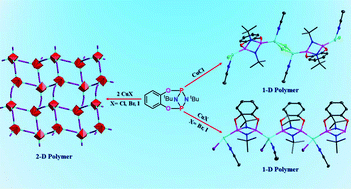Catechol and 1,2,4,5-tetrahydroxybenzene functionalized cyclodiphosphazane ligands: synthesis, structural studies, and transition metal complexes†‡
Abstract
Syntheses of two novel cyclodiphosphazane derivatives appended on catechol and 1,2,4,5-tetrahydroxy benzene, [{(μ-N(tBu)P)2(C6H4O2)}] (1) and [{((μ-N(tBu)P)2)2(μ-C6H2O4)}] (2), are described. Reactions of 1 with copper(I) halides led to the isolation of one-dimensional (1-D) and two-dimensional (2-D) coordination polymers, depending on the reaction conditions, metal-to-ligand ratio and CuX (X = Cl, Br or I) employed. The 1 : 1 reaction between 1 and CuCl yielded a 1-D coordination polymer [{(μ-N(tBu)P)2(C6H4O2)}{Cu(μ2-Cl)(NCCH3)}2]n (3) containing [Cu(μ2-Cl)]2 rhombus units. Similar reactions of 1 with CuBr and CuI produced rare 1-D coordination polymers [{(μ-N(tBu)P)2(C6H4O2)}{CuX(NCCH3)}]n (4, X = Br; 5, X = I) with discrete copper atoms linked by bridging cyclodiphosphazane ligands. However, the reactions of 1 with CuX (X = Cl, Br or I) in 1 : 2 molar ratios afforded 2-D coordination polymers [{(μ-N(tBu)P)2(C6H4O2)}2{Cu4(μ3-X)4}]n (6, X = Cl; 7, X = Br and 8, X = I) containing cuboids [Cu4(μ3-X)4] with 1 linking such units. Treatment of 1 with [RuCl2(η6-p-cymene)]2, [Rh(COD)Cl]2 and [Pd(η3-C3H5)Cl]2 in 1 : 1 molar ratios produced dinuclear complexes [{(μ-N(tBu)P)2(C6H4O2)}{RuCl2(η6-p-cymene)}2] (9), [{(μ-N(tBu)P)2(C6H4O2)}{RhCl(COD)}2] (10) and [{(μ-N(tBu)P)2(C6H4O2)}{PdCl(η3-C3H5)}2] (11), respectively. The reaction between 1 and [AuCl(SMe2)] in a 1 : 2 ratio yielded a dinuclear complex [{(μ-N(tBu)P)2(C6H4O2)}{AuCl}2] (12). The reactions of 2 with [RuCl2(η6-p-cymene)]2, [Rh(COD)Cl]2 and [Pd(η3-C3H5)Cl]2 in 1 : 2 molar ratios afforded tetranuclear complexes [{((μ-N(tBu)P)2)2(μ-C6H2O4)}{RuCl2(η6-p-cymene)}4] (13), [{((μ-N(tBu)P)2)2(μ-C6H2O4)}{RhCl(COD)}4] (14) and [{((μ-N(tBu)P)2)2(μ-C6H2O4)}{PdCl(η3-C3H5)}4] (15), respectively. The reaction of 2 with [AuCl(SMe2)] also afforded a tetranuclear complex [{((μ-N(tBu)P)2)2(μ-C6H2O4)}{AuCl}4] (16). In all these complexes, ligands preferred a bridged bidentate mode of coordination. Compounds 3–8 are the rare examples of 1-D and 2-D copper(I) coordination polymers containing cyclodiphosphazane ligands. The crystal structures of 2–8, and 15 were established by X-ray diffraction studies.

- This article is part of the themed collection: Inorganic chemistry of the p-block elements


 Please wait while we load your content...
Please wait while we load your content...